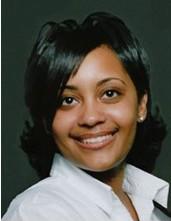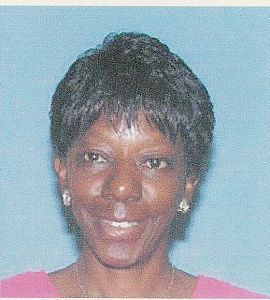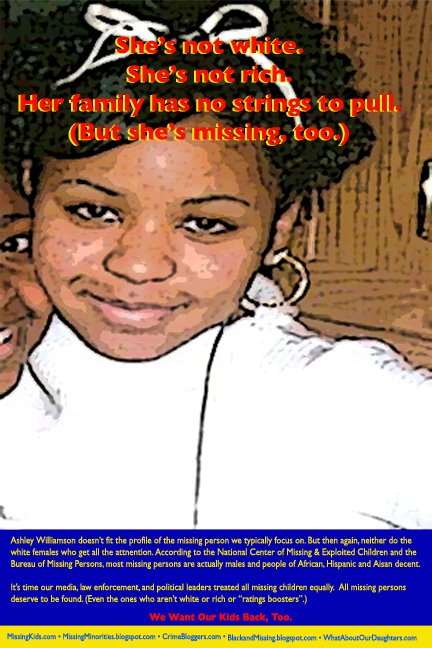Wednesday, December 10, 2008
Here's an idea...
Whatever the case, white, black, male, female, rich, poor, family members just want their stories heard. So from now on, I say media uses this general term, “missing person’s syndrome.” And the only requirement needed for coverage, is you’re reported missing and your family needs help finding you.
Facts and stats...
Whereas, your non-white victims come from single parent homes. Some live in poverty and have struggled throughout life. Some were even known prostitutes and drug users. Not your typical “damsel in distress” in need of rescue, if you will.
Now some may say the disparity in coverage can be explained in terms of numbers? When you stop and think about it, White Americans make up the majority in society. The latest stats show whites account for 70% of the population, compared to blacks and Hispanics combined, make up around 28% of the population. And not only that, white women have the highest reported numbers compared to non-whites of missing persons. But should that matter when it comes to coverage? No, a missing person white, black or Hispanic is still a missing person. And every effort/advantage available should be given.
However others say, it’s not a conscious decision to give more coverage to one story. They believe the “mwws” formula works. News organizations simply say their coverage has nothing to do with numbers, race or wealth. They say competition from another news outlet and unusual or extraordinary circumstances are some of the determining factors. Not to mention the persistence of the family helps.
Now some may say the disparity in coverage can be explained in terms of numbers? When you stop and think about it, White Americans make up the majority in society. The latest stats show whites account for 70% of the population, compared to blacks and Hispanics combined, make up around 28% of the population. And not only that, white women have the highest reported numbers compared to non-whites of missing persons. But should that matter when it comes to coverage? No, a missing person white, black or Hispanic is still a missing person. And every effort/advantage available should be given.
However others say, it’s not a conscious decision to give more coverage to one story. They believe the “mwws” formula works. News organizations simply say their coverage has nothing to do with numbers, race or wealth. They say competition from another news outlet and unusual or extraordinary circumstances are some of the determining factors. Not to mention the persistence of the family helps.
White women are always missing...
The latest stats show an average of 22,000 women have been reported missing. To break that number down by race, almost 62% are white and 29% are black. Now while the numbers show that white women have the highest numbers, they're not the only ones missing.
A 24-year-old African-American woman named Tamika Huston of Spartanburg, S.C., was reported missing by her family. Now you probably haven't heard of Huston or even know her face, even though her family did everything to get her name out there. Huston's aunt, Rebkah Howard who's a public relations professional, distributed fliers, held a press conference and created a Web site to get mass media attention, but her story was overlooked. As the search for Natalee Holloway, a white woman continued.
A June 16th article in the USA Today posed this question to the media. "Why doesn't the media show as much concern for non-whites?" Howard believes it's a simply a trend. A formula if you will.
She told "The Early Show's" co-anchor Hannah Storm she doesn't believe executive producers and newsroom staff consciously exclude persons of color, but notes it is important for the media to take a critical look at which cases they cover.
"What I believe is happening," Howard says, "is that networks have found a formula that has worked for them. And they tend to be about young, white attractive, middle- to upper-class women. And they continue to follow those stories. As one is resolved, they'll move on to the next one. I was met with a lot of resistance when I tried to get national attention for this case. It has been unfortunate."
Huston's body was found. Her ex-boyfriend confessed to killing her.
A 24-year-old African-American woman named Tamika Huston of Spartanburg, S.C., was reported missing by her family. Now you probably haven't heard of Huston or even know her face, even though her family did everything to get her name out there. Huston's aunt, Rebkah Howard who's a public relations professional, distributed fliers, held a press conference and created a Web site to get mass media attention, but her story was overlooked. As the search for Natalee Holloway, a white woman continued.
A June 16th article in the USA Today posed this question to the media. "Why doesn't the media show as much concern for non-whites?" Howard believes it's a simply a trend. A formula if you will.
She told "The Early Show's" co-anchor Hannah Storm she doesn't believe executive producers and newsroom staff consciously exclude persons of color, but notes it is important for the media to take a critical look at which cases they cover.
"What I believe is happening," Howard says, "is that networks have found a formula that has worked for them. And they tend to be about young, white attractive, middle- to upper-class women. And they continue to follow those stories. As one is resolved, they'll move on to the next one. I was met with a lot of resistance when I tried to get national attention for this case. It has been unfortunate."
Huston's body was found. Her ex-boyfriend confessed to killing her.
Subscribe to:
Posts (Atom)







